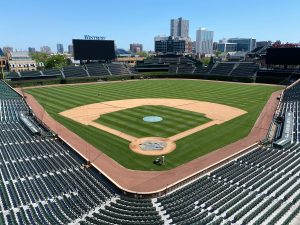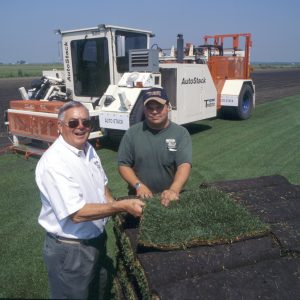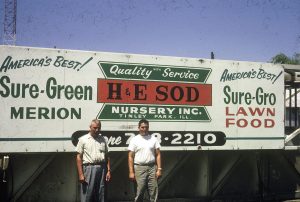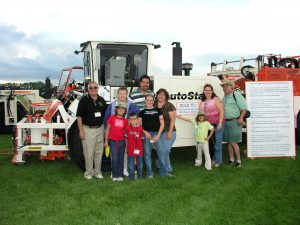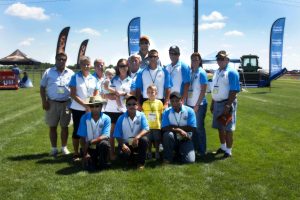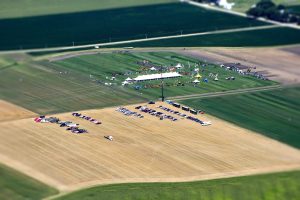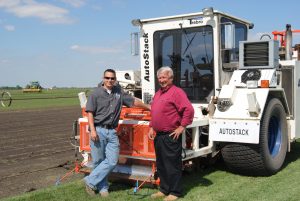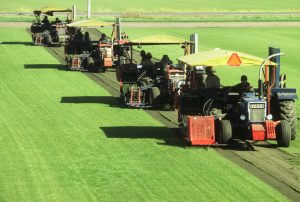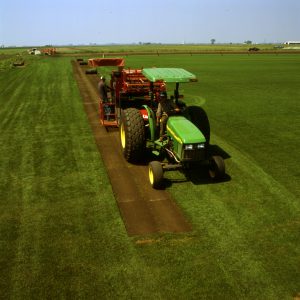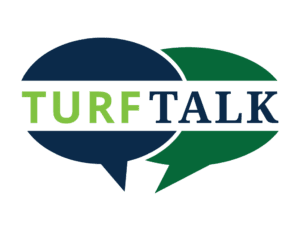
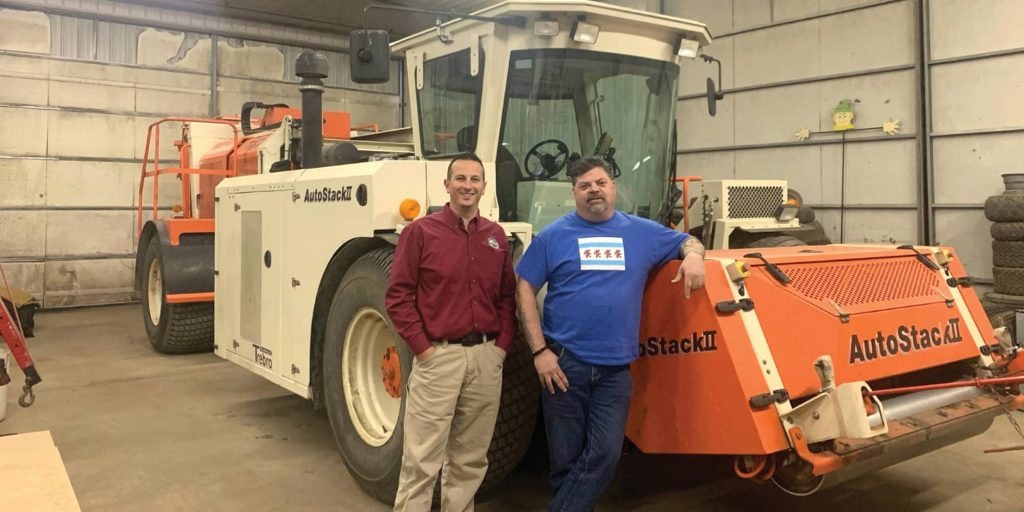
Payne Sod Farm to Become Wholesale Contract Grower for H & E Sod Nursery
Two major sod farms in Illinois are joining forces and making a major transition to kick off the 2021 season. Payne Sod Farm, Inc. has announced it will move forward as a wholesale contract grower for H & E Sod Nursery, Inc. With a longstanding relationship between the two farms, both H&E Vice President Darin Habenicht and Payne Vice President Justin Payne agree this is a positive decision for both sod farms.
“We are very thankful for all of our customers that have done business with us over the past 45 years,” Payne said. “Sod farming is a lifestyle, and it will be a major change for my father and I to take a step back and just be growers. With the success we’ve had we aren’t closing the door on this book, we are just making a major plot twist in this turfgrass drama-filled life we live.”
During that time, Payne Sod Farm has completed numerous sod installations that include over 75 public and private golf courses in four states, professional sports fields, hospitals, universities and zoos as well as home, commercial and roadside projects. Eight states have sod from Payne Sod Farm.
Payne said they’re excited to start this season with a different thought on how they grow grass and how they can help the sod industry grow.
The farms located nearly 10 miles from one another serve as major sod producers for the entire region. Payne recalls a time when there were over seven sod farms in the surrounding area but said that’s just not the case anymore. He got his start forking and rolling sod fields when he was 11 years old. Then when he turned 14, it became day-in, day-out of driving tractors, loading trucks and helping with anything he could. When he graduated college, he tried a few jobs and eventually came back to work full time on the farm in 2000. He explained the lifestyle of sod farming is not like other farming operations or occupations and he is ready to slow things down and look out for his family’s future.
“It’s almost a 365-day business. Basically from sun-up to sun-down you’re trying to keep everything going and moving forward. So, we equate it to a lifestyle and sometimes it’s good, sometimes it’s bad. I’m just looking for a change now,” he said.
In 2020, the Chicago market started to see a slight shortage of supply. Payne shared that when COVID hit, most sod farms weren’t prepared, so they spent time debating whether to move grass or wait.
Since Payne Sod Farms had extra sod and knew H&E wanted more, they started helping supply them with sod throughout last summer. By the end of the year, Payne said they were really pleased with how things were working between the two farms. He had also acknowledged that he was looking for a change of pace and figured a long-term partnership with H&E was a potential solution.
Moving forward, Payne will grow the grass and H&E will harvest and market the grass, handling all of the logistics through distribution. As the season opens, Payne is switching clientele over to contact H&E for orders. Both farms understand there will be some learning curves, but they’re prepared for the transition.
H&E’s Darin Habenicht, who is himself, a third-generation sod producer said he’s looking forward to this opportunity for H&E. His grandfather and father both created and grew their business into what it is today.
Pictured (left) are Dale and Darin Habenicht by an AutoStack in 2004. Pictured (center) are Carl and Dale Habenicht in the early 1960s. Pictured (right) is the Habenicht family in Dayton, Ohio Field Day during the Turfgrass Producers International show in 2003.
“It’s a seven-day a week job for basically a dozen weeks. And it’s fun. You don’t get much sleep over it, but I have a fairly large family and a lot of my children want to move in this direction,” Habenicht said.
He anticipates most of his children will end up working on the farm when they are older.
“It took me a while to realize the family business isn’t all that bad. And there’s enough space for me and dad to basically be two peas in a pod. I’m a Xerox copy of him, just thirty years younger. And with being able to be separated by distance, I was able to go back into the company. I’ve been working for my dad since I was 14,” Habenicht said.
H&E has other multi-generational families working together on the farm as well. Habenicht shared that for the first time this year, they had a third-generation, or grandson of an employee, begin working on the farm. He said they are very family-oriented which is why they love attending the Turfgrass Producers International (TPI) annual trade show not only for business purposes but also because most attendees are family-based partners.
Photos above are from the Turfgrass Producers International show held at Payne Sod Farm in 2013.
History between the farms
Payne’s father, Ron, grew his first crop in the late 1970s upon moving back to the Bradley area when he got out of the military. Ultimately, he decided he wanted to grow grass after working as a superintendent. Ron grew so much during his first season that he called Dale at H&E to come pay a visit. Dale flew a plane down just one mile north of Payne Sod Farms and they walked the entire field together. Dale ended up buying all of the sod, creating the start of a long withstanding relationship between the two farms.
Since then, Payne Sod Farms has sold sod to H&E almost every year up until 2006. In 2007, Payne said they were expanding, and everyone was consuming everything they were growing so they didn’t have extra to sell other sod companies. The downturn in the economy from 2008 through 2011 changed how the farm was operating. During that time several different sod farms in the Midwest quit growing sod and closed up. It wasn’t until 2012 that Payne saw a good rebound in sales and was able to start increasing acreage again.
“We’ve grown consistently from then each year all the way up to last year being probably our biggest year. And a lot of people have asked if you’re doing so good, why would you get out now,” Payne said.
His answer is that he wants to leave on a high note and look at operating the farm differently than they do right now to reduce stress levels. Payne said he hit a burnout stage over the past few years and is hopeful to step back with an easier weekday schedule so he can spend weekends and holidays with his family.
Of the vendors and customers he has already told, Payne said most have been supportive of his decision. Payne said there are still good, fun days on the farm, but he doesn’t enjoy it as much as he did when he was younger. His father’s passion to grow grass is still very much there, which is a main reason they’ll continue to grow, as a contract grower for H&E.
Ultimately, Payne is hoping to grow better grass more easily and allow H&E to handle harvesting, logistics, employees, customers, vendors, regulations and other parts of the business that he is no longer interested in. Payne is thrilled to be joining efforts with H&E, a farm he has over 30 years of memories of working with.
Payne said over the years Payne Sod Farm has grown sod and helped other sod farms in various ways. He knows of some Wisconsin and Michigan farms, a few farms on the East Coast and some in the south that have partnered to become sod sellers and some only growers to keep going.
“I think it’s going to be something that we’re going to see more and more of as time goes by,” Payne said.
Payne recalls when extremely large and frequent loads of sod would leave the farm. He’s hopeful the joint partnership with H&E will allow them to see those types of trends again.
“I’ll never forget the first time I saw three auto stacks rolling in a field all at once. It was a sea of semis and pallets back in 2005-07. It was just trucks in and out for weeks on end and you could just wipe out 50-60 acres in a matter of a couple of weeks,” Payne said.
Payne is hopeful H&E will come once in the spring and once in the fall to cut all of the sod they need for customers, rather than how they operate now at Payne Sod Farms cutting seven days a week for the same acreage.
H&E’s future
H&E has several satellite farms throughout the region and is currently growing seven grass varieties. These varieties are sold in 60 stores, including Lowes, Menards and Home Depot.
Habenicht sees a big difference as people realize real estate is expensive and online sod purchases are seeing an influx. Habenicht said they have a wide-demand market of golf courses that want their bluegrass and fine fescue varieties, including North Carolina courses in the Highlands, Brevard and Boone.
Habenicht noted that most growers have a crop in addition to sod they can sell. He believes it’s important for farmers to get more into the retail side of the business now and to consider a crop that is recession-proof.
“If the economy takes a crap and people aren’t buying houses, then they’re not buying sod,” he said. “So, you’ve got to find other markets that are recession-proof. Hemp is a crop I look at as a good way to get into that.”
Hemp will be something H&E Sod Farm will rotate within their other crops, such as wheat, straw and corn bundles that they’ll sell to box stores. Habenicht believes online sales will help their business over time.
In the next five to ten years, Habenicht is hopeful several of his children will become involved as they get older and married.
“It’s a matter of growing forward with my kids and moving on to the next generation so that I can start backing off and relaxing a little bit,” he said.
This article was written by Cecilia Brown.

